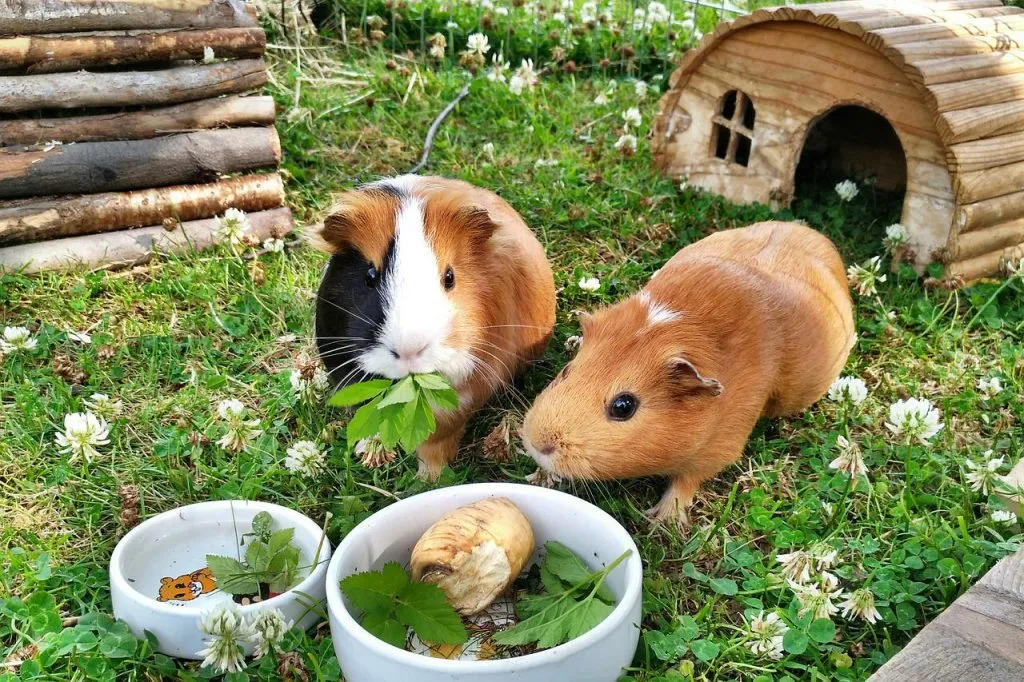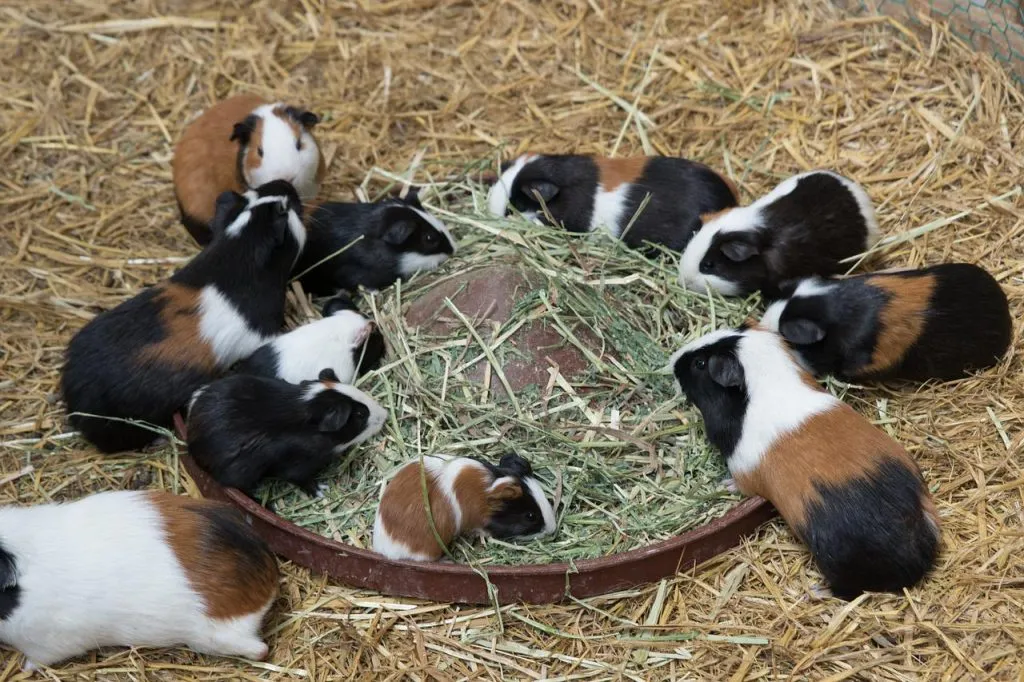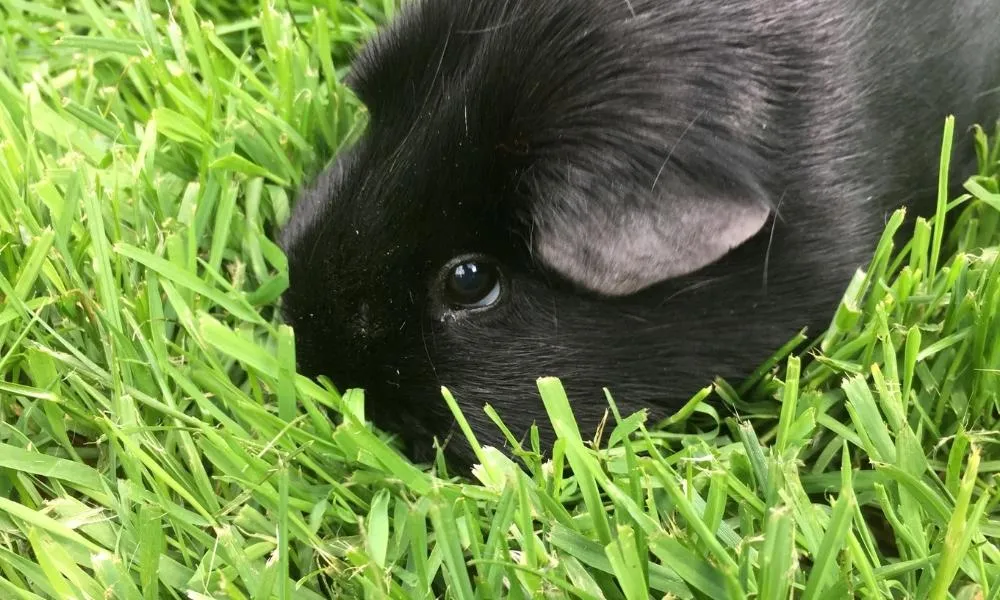Perhaps you recently saw your guinea pig chewing, even when there’s no food around.
Does it mean guinea pigs are ruminant animal like a sheep?
No – Guinea pigs have one stomach compartment, which means they are not ruminant animals.
But when they eat a lot of fibrous food, it passes through the caecum and colon (large intestine). As a result, food digestion happens the same way as that of ruminant animals.
In other words, guinea pigs chew soft diets once and chew hard fibrous diets two times.
Now, I believe you have a little idea why your guinea pig was chewing several minutes after eating. At this point, you’ll probably be wondering, how do guinea pigs digest food?
Continue reading to find out!
Table of Contents
How Do Guinea Pigs Digest Food?

Interestingly, guinea pigs digest food the same way humans do. They digest most of their food in the large intestine (colon and caecum).
Located at the end of the junction of the small and large intestine is the caecum. It contains about 65% of the gastrointestinal contents.
Keep in mind that guinea pigs cannot digest cellulose. For this reason, there are bacteria and protozoa in their caecum, which allows easy digestion of food.
Most of the diets guinea pigs eat do not digest by the time they get to the caecum. When the fiber (cellulose) arrives at the caecum, it is broken down and used by bacteria and protozoa.
Eventually, the bacteria and other microflora produce waste in the form of fatty acids, which are sources of energy for cavies. Thereafter, the microflora is excreted through the caecum during digestion.
This is the major reason guinea pigs eat their poop (cecotrophy). They do this to restore the microflora in their body and to gain necessary nutrients.
So, when you see your little cavy chewing when there’s no food nearby, it is probably the feces.
To ensure these bacteria and other microflora function perfectly, feed your guinea pigs fiber-rich diets. Little or no fiber in their diets can cause changes in the caecum PH and too much bacteria.
Over time, your small pets may begin to experience indigestion, stooling, and other stomach-related problems.
What Kind Of Food Do Guinea Pigs Eat?
Naturally, guinea pigs are herbivores; plant-eaters. Hence, their diets should consist of healthy plants only.
Here are 4 kinds of food guinea pigs eat:
1. Hay
Hay can be considered the guinea pigs’ favorite diet. It is rich in fiber, thereby enabling easy digestion of food in guinea pigs. Besides, hay also helps the little pets wear down their ever-growing teeth.
Bear in mind that not all hay is healthy for your little pets. Preferably, go for Timothy hay as it is considered healthy for your guinea pigs.
Interesting Read: Can Guinea Pigs Eat Grass Instead Of Hay?
2. Vegetables
Just as hay is important for cavies, so are fresh vegetables. In fact, it is recommended that you serve your guinea pigs a cup of fresh vegetables every day.
Make sure you wash these plants before giving your pets, to remove pesticides and dirt. Try to give them different veggies, so that they can gain many nutrients at a time.
But do not overfeed the small pets with vegetables, to prevent diarrhea.
In addition, keep in mind that not all veggies are healthy for your guinea pigs.
Here’s a list of vegetables you can offer them:
| Zucchini | Spinach | Cabbage |
| Cilantro | Carrots | Radish |
| Parsley | Celery | Asparagus |
| Lettuce | Broccoli | Kale |
| Green beans | Cucumbers | Sweet potato |
3. Fruits
Fresh fruits are also parts of the food guinea pigs eat. However, they shouldn’t be served all fruits because some are not healthy for them.
Guinea pigs do not produce vitamin C, which means they have to depend on diets rich in this vitamin. When served in moderation, fruits improve the general health of your guinea pigs.
Here is a list of healthy fruits your guinea pigs can eat:
| Apple | Apricot | Banana | Strawberry | Cherries |
| Cranberries | Grapes | Kiwi fruit | Melon (All types) | Blueberries |
| Tomatoes | Papaya | Peach | Pear | Pineapple |
| Plums | Raspberry | Oranges | Radish | Watermelon |
4. Pellets
Pellets are commercial foods that have been specially prepared for guinea pigs.
They contain essential nutrients, including vitamin C, which is important for your cavies’ overall health. Pellets are good for pregnant, nursing, or underweight guinea pigs.
Just make sure you check the manufacturer’s instructions before filling your guinea pig’s plate with pellets.
What Are Examples Of Ruminant Animals?
Ruminant animals have four-chambered stomachs. They chew their food, swallow, bring it up to their mouth, chew, and then swallow.
Here are 10 examples of ruminant animals:
1. Cattles
2. Goats
3. Sheep
4. Antelope
5. Deer
6. Musk
7. Giraffe
8. Moose
9. Okapi
10. Chevrotains
Related Questions:
Do Guinea Pigs Cud?

No, guinea pigs do not cud because they are not ruminant animals. However, if they have lots of fibrous diets, the food will not digest once.
So, they’ll have to pass it out as feces and then eat it again (cecotrophy) to gain the necessary nutrients.
Do Guinea Pigs Regurgitate?
No, guinea pigs do not regurgitate like ruminant animals. A cavy’s brain and the body were not designed to throw up food.
Therefore, avoid feeding your pets toxic or hard diets to prevent a choking hazard.
It is also important to serve your guinea pigs little, healthy food at a time.
Are Guinea Pigs Hindgut Fermenters?
Yes, guinea pigs, the same as other monogastric herbivores, are hindgut fermenters.
They have larger and more complex caecum and large intestine. Besides, the hindgut fermenters cannot digest cellulose directly, except with the help of bacteria in their caecum.
Microbial fermentation goes through the same pattern in their digestive system. It follows the small intestine, large intestine, and cecum.
Other hindgut fermenters include rabbits, rodents, rhinos, and horses.
Final Thoughts
Now, we’ve come to the final part of this article. But before you leave, keep a few points in mind.
Guinea pigs are not ruminant animals. However, they eat hard, fibrous diets more than once to make sure digestion takes place.
Digestion of diets in guinea pigs takes place the same way as that of humans.
Always feed your cavies hay, vegetables, fruits, and pellets so that they can grow healthily.
Ruminant animals include cattle, goats, sheep, antelope, and deer.
Guinea pigs do not cud, nor do they regurgitate because they are not ruminant animals.
Finally, guinea pigs are hindgut fermenters, the same as other monogastric herbivores.
